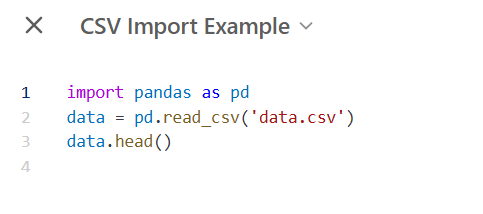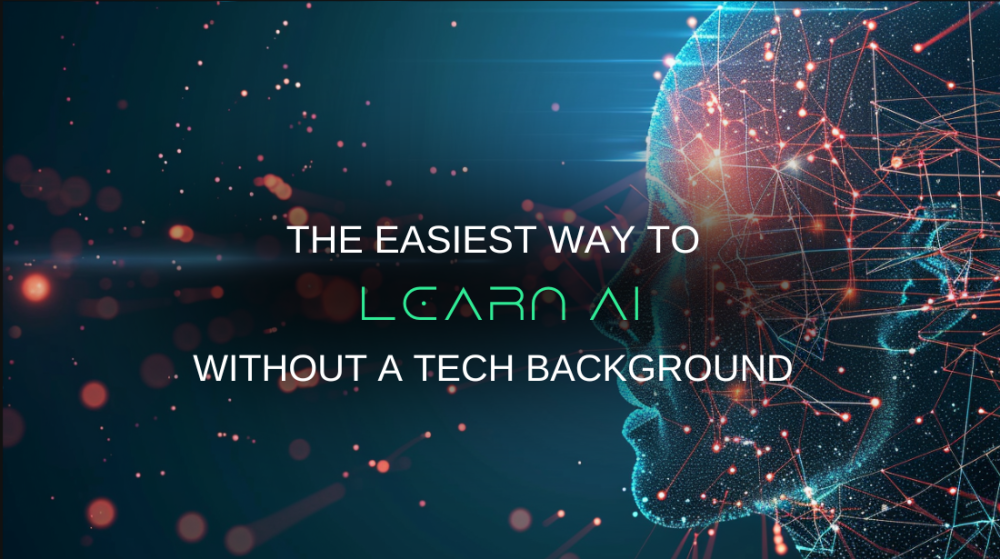What’s the Easiest Way to Learn AI without a Tech Background?
Welcome to your crash course in AI, fast, friendly, and made for real people with real jobs. Whether you're a teacher, a small business owner, a marketer, or just someone who wants to keep up with the times, you're in exactly the right place.
You don’t need to code. You don’t need to be technical. All you need is curiosity and a willingness to try. Here, you willl not only understand what AI is doing in the world—you’ll be ready to use it yourself. So, let's begin.
Lesson 1: AI Isn’t the Future, It’s Already Here
Forget science fiction and robots for a moment. AI isn’t some distant, high-tech fantasy. It’s already in your life, quietly working behind the scenes.
When Netflix suggests a show you might like, that’s AI. When your phone autocorrects a word or gets it hilariously wrong, that’s AI too. If you’ve ever used voice assistants like Siri or Alexa, you're already working with AI.
And these aren’t isolated tricks; they’re signs of a shift. AI is now the engine behind tools that save time, boost creativity, and simplify work. You don’t need to be technical to tap into it. You just need to know where to look and how to ask.
What You Really Need to Know Before Using AI Tools
Let’s say you’re curious about getting started with AI but you’re not a programmer or data scientist. No problem, you don’t need to jump into complex algorithms right away. What really helps in the beginning is just understanding the basics. Before you even touch a tool, knowing these core ideas helps you see where AI fits into everyday problems. From there, everything else starts to make a lot more sense.
So, here’s the deal: when we talk about AI, we’re really talking about computers doing things that usually need human thinking, like making decisions, recognizing patterns, or understanding language. It’s not magic, it’s just machines being trained to think a bit more like us.
Now, you’ve probably heard the term "machine learning.” That’s one of the main ways AI works. Instead of being told exactly what to do step-by-step, the system learns from data, similar to how we learn from experience. Show it enough examples, and it starts figuring things out on its own.
Then there is natural language processing (NLP). That’s what lets AI understand and respond to human language. If you’ve ever used a chatbot or seen your phone summarize an email, that’s NLP in action.
And finally, computer vision. This is what gives machines the ability to "see,” not literally, but they can analyze images and videos. It’s used in things like facial recognition, medical imaging, and even factory inspections.
Lesson 2: Try It Yourself; No Code Needed
The best way to understand AI is to actually use it. The good news is that you don’t need to download anything or write a single line of code. All you need is a browser and a little curiosity.
Let’s start with one of the most talked-about tools, ChatGPT. Go to the ChatGPT website, sign up for a free account, and open a new chat window. ChatGPT isn’t just spitting out fixed answers; it listens, adapts, and lets you shape the output until it feels just right.
Try one real task, something you’re already doing this week. Let AI help. You’ll be surprised. You can try this:
Example Prompt:
"Can you help me write a polite and professional email to a client who missed our meeting today? Let them know it's okay, suggest rescheduling, and keep it under 100 words.”
You’ll get a response in seconds. You can ask it to adjust. You could say:
Example Prompt:
"Make it more casual,” or "Add a little empathy,” or "Turn this into a text message.”
Other Tools that Work
Lesson 3: Better Results Start with Better Prompts
Something most people miss when they start using AI is that the tool is only as good as the instructions you give it. This is the core idea behind the concept "prompt engineering.” Don’t let the term scare you; it just means learning to ask better questions and give more context so the AI can help you more effectively.
One of the easiest ways to learn is by trying the same request in a few different ways. Adjust the length, tone, or purpose each time and pay attention to how the results change. Let’s say you want to generate content. If you simply type, you’ll probably get a generic, unhelpful response. But now try giving it more direction.
Example Prompt:
"Write a 150-word article that explains how artificial intelligence is helping teachers personalize learning in schools. Use a friendly tone, avoid technical jargon, and include a real-world example.”
If you want something for social media, you can just say:
Example Prompt:
"Create three Instagram captions to promote the grand opening of a coffee shop in Brooklyn. Use a casual, fun tone that would appeal to local residents. Mention free samples or a special launch-day offer.”
Lesson 4: Understanding Data Without Getting Overwhelmed
You’ve probably heard this phrase a hundred times: "AI runs on data.” And while it’s absolutely true, it doesn’t mean you need to become a data scientist to use AI effectively.
Think of data as nothing more than organized information. It could be a spreadsheet of student grades, a list of customer reviews, or monthly sales figures. The value isn’t in the data itself; it’s in what you can ask AI to do with it.
Let’s say you’ve collected 50 customer reviews in a spreadsheet. Instead of manually reading each one, try a prompt like this:
Example Prompt:
"I have 50 customer reviews in this list. Can you analyze them and tell me the top three recurring themes customers mention? Also, summarize the overall sentiment: are people generally happy, neutral, or dissatisfied?”
Lesson 5: Find a Course
If you really want to get comfortable with AI, the smartest move is to take a course, one that’s accessible, beginner-friendly, and focused on practical use. You don’t need a tech background or a big time commitment to get started.
The Evolution of Artificial Intelligence: A Journey from Theory to Practice
This course offers a deep, well-rounded introduction to the world of AI. You will explore foundational concepts like machine learning, natural language processing, and computer vision, learning not just how these technologies work, but how they’re used in real-world situations.
It’s designed to give you insight into predictive modeling and help you think critically about AI’s role in society, ethics, and the future of work. Whether you're new to the field or looking to connect the dots between theory and application, this course will leave you with a solid understanding of how AI systems function and why they matter.
The course is led by Nadine Brehmer, an experienced AI educator known for making complex ideas approachable. With decades of real-world experience, she brings clarity and structure to topics that often feel overwhelming. Her teaching bridges technical knowledge with real-world use, empowering learners from all backgrounds to engage confidently with AI concepts and tools.
Enroll Here: https://aiixx.ai/courses/view/The_Evolution_of_Artificial_Intelligence_A_Journey_from_Theory_to_Practice

Prompt Engineering in 30 Minutes
If your goal is to start using AI tools right away, Prompt Engineering in 30 Minutes is a fast, focused way to get up to speed. This course teaches you how to write clear, effective prompts for tools like ChatGPT, adjust responses to suit your needs, and understand what these models can and can’t do. Through practical, hands-on exercises like summarizing content, brainstorming ideas, and rewriting text, you’ll gain the skills to get better results from generative AI in just half an hour. It's lightweight, beginner-friendly, and designed to give you maximum impact with minimal time investment.
The course is perfect for beginners, regular users of AI tools, content creators, business users, students, educators, or anyone curious about making AI work efficiently.
This course is curated by the AI IXX education team, built around real-world testing and applications. It’s a practical course that avoids fluff and gets straight to helping you improve your results with generative AI.
Enroll Here: https://aiixx.ai/courses/view/Prompt_Engineering_in_30_Minutes
Foundations of AI
If you're looking for a strong, beginner-friendly introduction to artificial intelligence, Foundations of AI is a great place to start. This course breaks down the core concepts behind AI, machine learning, and deep learning in a way that's easy to grasp, even if you’ve never written a line of code.
You will explore how different AI models work, learn the basics of supervised and unsupervised learning, and apply what you’ve learned to real-world examples. By the end, you’ll understand how AI is used across industries and be able to start experimenting with tools and concepts on your own, with confidence.
Enroll Here: https://aiixx.ai/courses/view/Foundations_of_AI

Lesson 6: Understand the Basics of Working With Data
Start with what you already have. Maybe it's customer feedback, sales reports, or product images. That’s your data. Learning how to collect and organize it is the first step.
Then, clean it. Real data is messy, with missing values, typos, and inconsistencies. Cleaning it up makes sure any AI tool or analysis you apply gives you reliable results.
Finally, look for patterns. You don’t need advanced software. Just open up Excel or Google Sheets. Can you spot trends? Peaks in sales? Repeating complaints? That’s data analysis, and it’s often where the real insights live.
When you understand your data, everything else becomes easier. Your prompts get sharper. Your tools get smarter. And your decisions get better.
So don’t skip this step. Learn to see the story in the numbers. That’s how you make AI work for you.
Lesson 7: A Gentle Intro to Python
Once you're comfortable with the basics, learning a bit of Python can take your AI skills further. It’s the most commonly used language in AI, and knowing how to read or tweak simple scripts opens the door to more advanced tools and customization.
Python is the most common language used in AI work. It’s readable, almost like English. You’ll see things like this.

Use a free browser-based notebook that lets you write and run Python code instantly. Search for "beginner Python AI tutorial” or ask ChatGPT for one. Begin with a simple task like loading a CSV file and displaying the top 5 rows.
Want a guided start? You can learn Python for AI from the basics in our free course Python for AI. It walks you step by step through reading data, cleaning it with Pandas, and preparing it for AI projects.
Lesson 8: Build a Small But Real Project
By now, you’ve seen what AI can do. You’ve played with tools, you’ve written prompts, maybe even tested out a few ideas. So your next move is to build something small. It doesn’t have to be perfect. Just real.
Think of a task you already do as a part of your daily workflow. Maybe you write newsletters. Maybe you spend too much time sorting messages, answering the same questions, digging through sales data, or going back and forth scheduling meetings.
Start with that one thing that can make things easier for you. You don’t need to create the next billion-dollar app. Maybe it’s a simple chatbot that answers common customer questions. Maybe it’s a tool you build with ChatGPT to brainstorm blog topics and draft outlines. The point is, pick something tiny and make it useful.
Lesson 9: Find Your People to Learn Together
Learning AI can feel like standing at the edge of a massive ocean. Tools are changing fast. New ideas pop up every day. It’s a lot. But you don’t have to do it alone.
There are thousands of people learning alongside you. They’re testing tools, sharing prompts, building weird and wonderful little projects. They’re asking questions you probably have too.
So plug into that energy. Join communities where learners gather. Reddit has great spaces like learn machine learning, where people share experiments and advice. Discord groups for tools that are full of curious minds. And don’t overlook it.
Wrapping Up
You’ve explored what AI can do. It’s not here to replace your creativity. It’s here to amplify it. To help you write quicker, test ideas faster, stay consistent, and bring more of your vision to life.
Now it’s your turn.
Pick something simple. A tweet. An email. A blog intro. Use what you’ve learned. Write a prompt. Shape the response. Refine it. Make it yours. And then publish.
That’s the cycle. That’s how it grows.
You don’t need to master everything at once. You just need to keep showing up, one prompt, one project, one small win at a time.
And more importantly, have fun doing it.
This is just the beginning.





